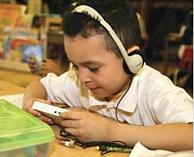The Coming E-ducation

The cover of this month’s issue of Fast Company has an excellent article by Anya Kamenetz on how smart phones are leading the charge in revolutionizing traditional methods of teaching and learning. Kamenetz, who just came out with a new book titled DIY U (a great resource on the future of higher education) makes a compelling case for leveraging technology to create personalized learning modules for Digital Natives, “a generation that has never known a world without ubiquitous handheld and networked technology.”
For those of us who’ve watched the slow but exquisite disintegration of old media, it seems natural that a similar disruption is going to ripple through other industries that keep knowledge tightly under the purview of a few elites and which are defined by rigid rules and resistance to the adoption of technology. The education establishment falls squarely into this category.
Today, most classes cater to the lowest common denominator: the teacher makes sure the class doesn’t move ahead till the child who understands least is comfortable with the information. The ‘no child left behind’ approach, while admirable in philosophy, is problematic because its implementation hurts the brightest children.
We have to drastically upgrade our learning and testing methodologies to accommodate a world in which technology is the neural network through which we express ourselves and collaborate with each other. That means we have to create a system of learning and testing which gives students creative ways of understanding and communicating knowledge, and which adapts dynamically to their needs as they advance.
Enter TeacherMate, a handheld computer which is provided to each child in a class and which allows the child to learn and test according to his or her abilities. The teacher can download a report on how each child is doing from the TeacherMate, and track all of their progress. According to Kelly Flowers, who teaches first-grade at Henry Clay Elementary School in Chicago, TeacherMate has significantly improved the performance of her students in math and reading.
Most important, says Flowers, the TeacherMate works. She privately sorts her kids into three groups based on their reading skills — green (scoring at or above grade level), yellow (borderline), and red (underperformers). “This year, with TeacherMate, I started with 11 greens, 2 yellows, and 7 reds. By the middle of the year, I had just 2 reds. I can move a red to a yellow on my own, but this is my first year moving a red directly to a green. I’ve never seen that much growth in that short a time.” Flowers’s observations are backed up by preliminary University of Illinois research that suggests that reading and math scores in classrooms with TeacherMates are significantly higher than in those without.
TeacherMate is just one example of innovative tools coming to your child’s school soon.
Ayesha and Parag Khanna explore human-technology co-evolution and its implications for society, business and politics at The Hybrid Reality Institute.





